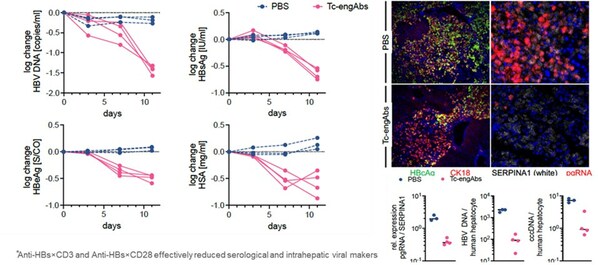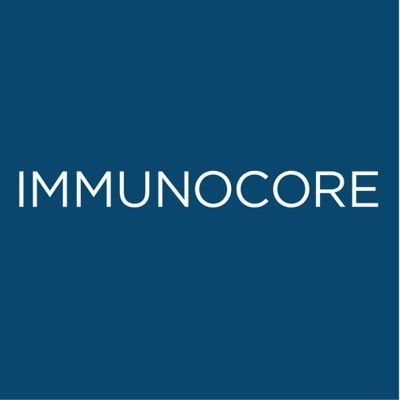预约演示
更新于:2025-05-07
CD3 x HBsAg
更新于:2025-05-07
关联
2
项与 CD3 x HBsAg 相关的药物作用机制 CD3刺激剂 [+1] |
原研机构 |
在研适应症 |
非在研适应症 |
最高研发阶段临床1期 |
首次获批国家/地区- |
首次获批日期1800-01-20 |
作用机制 CD3刺激剂 [+1] |
在研适应症 |
非在研适应症- |
最高研发阶段临床申请 |
首次获批国家/地区- |
首次获批日期1800-01-20 |
2
项与 CD3 x HBsAg 相关的临床试验ACTRN12620000403932
An Open-label Study Evaluating the Safety, Antiviral Activity, and Pharmacokinetics of IMC-I109V in HLA-A*02:01 Positive Patients with Chronic HBV who are Non-Cirrhotic, Hepatitis B e Antigen-negative, and Virally Suppressed
开始日期2021-05-18 |
申办/合作机构 |
NCT05867056
An Open-label Study Evaluating the Safety, Antiviral Activity, and Pharmacokinetics of IMC-I109V in HLA-A*02:01 Positive Participants With Chronic HBV Infection Who Are Non-Cirrhotic, Hepatitis B e Antigen-negative, and Virally Suppressed
IMC-I109V is an immune-mobilizing monoclonal T cell receptor (TCR) against viruses (ImmTAV®), a new class of bispecific protein therapeutics designed for the treatment of chronic hepatitis B virus (HBV) infection (CHB). This is the first in-human study of IMC-I109V in persons with CHB.
开始日期2020-08-12 |
申办/合作机构 |
100 项与 CD3 x HBsAg 相关的临床结果
登录后查看更多信息
100 项与 CD3 x HBsAg 相关的转化医学
登录后查看更多信息
0 项与 CD3 x HBsAg 相关的专利(医药)
登录后查看更多信息
61
项与 CD3 x HBsAg 相关的文献(医药)2025-04-01·JHEP Reports
Potential role of liver-resident CD3+ macrophages in HBV clearance in a mouse hepatitis B model
Article
作者: Zhang, Xiaonan ; Li, Yaming ; Zhao, Kuangjie ; Zhou, Xiaohui ; Yuan, Zhenghong ; Shi, Bisheng ; Wang, Cong ; Zai, Wenjing ; Kozlowski, Maya ; Fang, Zhong ; Wu, Min
2025-01-20·Zhonghua gan zang bing za zhi = Zhonghua ganzangbing zazhi = Chinese journal of hepatology
[Screening and functional identification of HLA-A*24:02-restricted HBsAg-specific TCR based on single-cell TCRαβ double-stranded amplification pairing].
Article
作者: Liao, B L ; Shi, M F ; Li, X Y ; Shen, G J ; Zheng, A Q ; Yu, Y C ; Wang, Z H
2024-12-06·Journal of Clinical and Translational Hepatology
Peripheral Blood CD4+/CD8+ T Cell Ratio Predicts HBsAg Clearance in Inactive HBsAg Carriers Treated with Peginterferon Alpha
Article
作者: Zhang, Xin ; Wu, Fengping ; Wang, Yikai ; Li, Yaping ; Dang, Shuangsuo ; Li, Miaoxian ; Jia, Xiaoli ; He, Ling ; Kang, Pei ; Li, Mei ; Lu, Rui ; Liu, Chenrui
7
项与 CD3 x HBsAg 相关的新闻(医药)2024-11-30
·药明康德
▎药明康德内容团队编辑
近期,全球细胞和基因疗法(CGT)领域迎来系列进展。耐化疗的转基因自体γδ T细胞疗法INB-200作为协同治疗方法,在一项1期临床试验中的表现亮眼,92%患者的无进展生存期(PFS)超过了接受标准治疗的患者。靶向BCMA的自体嵌合抗原受体(CAR)-T细胞疗法NXC-201在中位治疗线数为4线的复发/难治性轻链(AL)淀粉样变性患者中观察到75%(12/16)的完全缓解(CR)率。在1项靶向乙型肝炎病毒(HBV)特异性T细胞受体(TCR)-T细胞疗法SCG101的1期临床试验中,33%晚期HBV相关肝细胞癌(HCC)患者在接受单次SCG101输注后,其血清乙型肝炎病毒表面抗原(HBsAg)在21天内消失,并且这种状态持续了一整个随访期。本文将节选其中部分重要进展做简单介绍,仅供读者参阅。
图片来源:123RF
———✦研发进展✦———
◇ IN8bio公司公布其耐化疗的转基因自体γδ T细胞疗法INB-200加入到胶质母细胞瘤患者的替莫唑胺(TMZ)维持治疗中的1期临床试验数据。INB-200是一种强大的协同治疗方法,能在患者接受化疗时持续存在,并保持其识别和杀死癌细胞的能力。此次公布的结果显示,92%接受INB-200协同治疗的可评估患者的PFS超过了接受标准治疗(Stupp方案)患者的中位PFS(6.9个月),大多数患者的PFS超过了基于年龄和肿瘤MGMT状态预测的PFS。此外,5名患者仍然存活,3名患者已返回工作岗位,其中1名患者在治疗后40.5个月时疾病仍然没有进展。活检结果显示,两名患者在接受INB-200治疗后,脑肿瘤微环境中持续存在着γδ T细胞以及CD3阳性和CD8阳性T细胞。
安全性方面,任何队列中均未报告与治疗相关的严重不良事件、剂量限制性毒性(DLT)、细胞因子释放综合征(CRS)、输注反应或免疫效应细胞相关神经毒性(ICAN)。最常见的治疗相关不良事件是1-2级毒性,包括与标准护理TMZ相关的白细胞和血小板计数下降。
◇ Immix Biopharma公司公布了其靶向BCMA的自体CAR-T细胞疗法NXC-201治疗16名复发/难治性AL淀粉样变性患者的积极临床数据。结果显示,在中位治疗线数为4线的复发/难治性AL淀粉样变性患者中观察到75%(12/16)的CR率。
◇ 星汉德生物(SCG Cell Therapy)公布了其自主研发的HBV特异性TCR-T细胞疗法SCG101的1期临床试验的新数据。结果显示,SCG101在晚期HBV-HCC患者中显示出有希望的抗病毒活性。在接受单次静脉注射5.0×10^7-1.0×10^8个TCR-T细胞/kg剂量的SCG101治疗的12名患者中,所有患者的血清HBsAg水平均显著下降,其中11名患者(92%)的HBsAg水平下降了1.0-4.6 log10,并且在整个长达一年的随访期间,这些患者的HBsAg水平保持在100 IU/mL以下。值得注意的是,有4名患者(33%)在接受单次SCG101输注后的21天内实现了HBsAg的消失,并且这种状态持续了一整个随访期。SCG101的安全性总体上良好,治疗耐受性良好。最常见的治疗相关不良事件包括暂时性的肝酶升高、发热、细胞减少症、CRS、低白蛋白血症和低钠血症。
SCG101是一种靶向HBsAg的特异性自体TCR-T细胞疗法。星汉德生物依托自主研发的独有GianT技术平台,筛选高亲力且高活性的天然TCR,可以有效靶向实体肿瘤中通过主要组织相容性复合体(MHC)表达的细胞内抗原。临床前和临床研究数据显示,SCG101具有肿瘤抑制和HBV共价闭合环状DNA(cccDNA)根除作用,可实现抗肿瘤和抗病毒功能。
◇ S.BIOMEDICS公司宣布了其细胞疗法TED-A9在治疗帕金森病的1/2a期临床试验中的首批6名受试者的1年随访数据。结果显示,根据Hoehn和Yahr量表,低剂量组(n=3)患者的运动症状平均改善了19.4%,而高剂量组(n=3)改善了44.4%,表明疾病状态从严重转向较轻。步态冻结(帕金森病患者常见的运动症状之一)在低剂量组的部分患者(1/2)中完全消失,在高剂量组的所有患者(3/3)中完全消失。神经影像技术结果显示,由移植细胞形成的突触中多巴胺转运蛋白(DAT)增加,高剂量组更为明显。安全性方面,没有观察到与移植细胞相关的问题。
TED-A9是一款通过对人类胚胎干细胞(hESC)进行小分子化合物处理而生成的高度纯化中脑多巴胺能祖细胞。通过外科手术,hESC衍生的多巴胺能祖细胞被移植到患者双侧壳核的前、中、后部。移植后,这些细胞将成熟为多巴胺能神经元,通过增强帕金森病患者的神经连接,有望恢复患者的运动功能。
◇ 近期,美国贝勒医学院的研究团队在《自然》杂志发表了一篇论文,展示了一种经过双重改造的CAR-T细胞用于治疗实体瘤的1期临床试验结果。这种CAR-T细胞名为15. CAR-T细胞,既能靶向实体瘤常见抗原GPC3,同时也能表达IL-15。在这项研究中,接受常规的GPC3靶向CAR-T细胞治疗的实体瘤患者没有产生明显的抗肿瘤反应。而接受15. CAR-T细胞治疗的12位实体瘤患者中,疾病控制率(DCR)为66.7%(8/12)。有4人获得了部分缓解(PR),其中两位患者的肿瘤负荷至少下降了26%。该结果表明CAR-T疗法有望在实体瘤中同样起效。
———✦融资、合作、M&A✦———
图片来源:123RF
◇ 罗氏(Roche)宣布与CAR-T细胞疗法公司Poseida Therapeutics签署最终收购协议,总交易金额最高可达约15亿美元。Poseida的研发管线包括在多个治疗领域的现货型(同种异体)CAR-T疗法,涵盖血液恶性肿瘤、实体瘤和自身免疫疾病。此外,该公司还拥有先进的生产和技术平台。Poseida的主打研发项目P-BCMA-ALLO1是一种针对BCMA的同种异体CAR-T疗法,已获得美国FDA授予孤儿药资格与再生医学先进疗法认定,用于治疗经过三线或以上治疗的复发/难治性多发性骨髓瘤(RRMM)。Poseida的同种异体双靶向CAR-T疗法P-CD19CD20-ALLO1正在开展针对B细胞恶性肿瘤的1期临床试验,其针对多发性硬化和系统性红斑狼疮的IND申请已向美国FDA提交。
◇ 诺华(Novartis)宣布以总额11亿美元收购专注于开发AAV基因疗法的临床前阶段生物技术公司Kate Therapeutics。诺华预计此次收购将显著增强该公司在基因疗法和神经科学创新领域的战略布局。Kate Therapeutics的主要研发项目包括杜氏肌营养不良症(DMD)、面肩肱型肌营养不良症(FSHD)和Ⅰ型肌强直性营养不良症(DM1)的临床前候选药物。该公司的专有DELIVER平台结合了多样化衣壳文库生成、基于转录本的体内筛选以及机器学习技术,用于开发功能性衣壳变体。该平台已成功开发出一种新型肌肉靶向衣壳,这些衣壳在体内可高效且精准地递送至骨骼肌和心肌组织,同时有效避开肝脏。
◇ 基因和细胞治疗研发公司邦耀生物宣布完成近2亿元人民币B+轮融资,所得资金将用于全面推进其多管线产品的临床转化与上市进程,加速产品管线的全球化研发布局,为全球遗传疾病、恶性肿瘤及自身免疫系统疾病等患者带去希望。邦耀生物已有4个项目获得IND批准,包括针对输血依赖型β-地中海贫血的基因治疗产品BRL-101、靶向CD19的非病毒定点整合PD1-CAR-T细胞产品BRL-201、治疗中度或重度难治性系统性红斑狼疮的非病毒定点整合PD1-CAR-T细胞产品BRL-203,以及针对B细胞恶性肿瘤的UCAR-T产品BRL-301。此外,该公司还有多个项目进入了IND申报阶段。本轮融资由石药基金领投,贝达基金等机构跟投。
▲欲了解更多前沿技术在生物医药产业中的应用,请长按扫描上方二维码,即可访问“药明直播间”,观看相关话题的直播讨论与精彩回放
参考资料(可上下滑动查看)
[1] Immix Biopharma Presents Positive NXC-201 Clinical Data at 66th American Society of Hematology (ASH) Annual Meeting in 16 Relapsed/Refractory AL Amyloidosis Patients. Retrieved November 29, 2024, from https://immixbio.com/immix-biopharma-presents-positive-nxc-201-clinical-data-at-66th-american-society-of-hematology-ash-annual-meeting-in-16-relapsed-refractory-al-amyloidosis-patients/
[2] IN8bio Reports Continued Durable Remissions in Phase 1 Trial of INB-200 in Plenary Oral Presentation at the Society for Neuro-Oncology (SNO) Annual Meeting. Retrieved November 29, 2024, from https://investors.in8bio.com/news-releases/news-release-details/in8bio-reports-continued-durable-remissions-phase-1-trial-inb
[3] S.BIOMEDICS Investigational Cell Therapy for Parkinson’s Disease With TED-A9 Shows Positive Data at 12-months in Phase 1/2a Clinical Trial. Retrieved November 29, 2024, from https://www.businesswire.com/news/home/20241126606645/en/S.BIOMEDICS-Investigational-Cell-Therapy-for-Parkinson%E2%80%99s-Disease-With-TED-A9-Shows-Positive-Data-at-12-months-in-Phase-12a-Clinical-Trial
[4] SCG Cell Therapy Presents Promising Phase 1 Data for a Novel HBV-Specific TCR-T Therapy (SCG101) at the AASLD Liver Meeting 2024. Retrieved November 29, 2024, from https://www.prnewswire.com/news-releases/scg-cell-therapy-presents-promising-phase-1-data-for-a-novel-hbv-specific-tcr-t-therapy-scg101-at-the-aasld-liver-meeting-2024-302314896.html
[5] Interleukin-15-armoured GPC3 CAR T cells for patients with solid cancers. Nature (2024). DOI: https://doi-org.libproxy1.nus.edu.sg/10.1038/s41586-024-08261-8
[6] Roche enters into a definitive agreement to acquire Poseida Therapeutics, including cell therapy candidates and related platform technologies. Retrieved November 26, 2024 from https://www.globenewswire.com/news-release/2024/11/26/2987189/0/en/Roche-enters-into-a-definitive-agreement-to-acquire-Poseida-Therapeutics-including-cell-therapy-candidates-and-related-platform-technologies.html
[7] Addressing unmet needs for inherited neuromuscular diseases. Retrieved November 21, 2024 from https://www.novartis.com/stories/addressing-unmet-needs-inherited-neuromuscular-diseases
[8] 邦耀生物获近2亿元B+轮融资!加速推进多管线药物开发.Retrieved Nov 22,2024, From https://mp.weixin.qq.com/s/VQswaWKyebeoVGd_1G2vtQ
免责声明:药明康德内容团队专注介绍全球生物医药健康研究进展。本文仅作信息交流之目的,文中观点不代表药明康德立场,亦不代表药明康德支持或反对文中观点。本文也不是治疗方案推荐。如需获得治疗方案指导,请前往正规医院就诊。
版权说明:本文来自药明康德内容团队,欢迎个人转发至朋友圈,谢绝媒体或机构未经授权以任何形式转载至其他平台。转载授权请在「药明康德」微信公众号回复“转载”,获取转载须知。
分享,点赞,在看,聚焦全球生物医药健康创新
细胞疗法临床结果临床1期免疫疗法基因疗法
2023-07-13
·药创客
在刚刚结束的2023年欧洲肝脏研究协会(EASL)年会上,星汉德生物与来自德国汉堡大学-艾本多夫医学中心和慕尼黑工业大学的研究人员,共同公布了一项针对其全球首创的双特异性抗体(Anti-HBs×CD3和Anti-HBs×CD28)的临床前研究,在超过2000项报告中脱颖而出,获得了大会最佳报告奖(Best Presentation Award of EASL 2023)。该项研究显示,感染乙型肝炎病毒(HBV)的双重人源化小鼠在接受了短暂的Anti-HBs×CD3和Anti-HBs×CD28双抗的联合治疗后,有效激活了人源淋巴细胞,表现出强大的体内抗病毒免疫活性;HBV DNA、表面抗原(HBsAg)和e抗原(HBeAg)等所有病毒血清学标志物以及肝内HBV前基因组RNA(pgRNA)和共价闭合环状DNA(cccDNA)均显著降低,表明感染的肝细胞得到了有效清除。研究结果展示了该双抗组合实现乙肝功能性治愈的巨大潜力。慕尼黑工业大学/德国亥姆霍兹研究中心病毒学研究所所长、星汉德生物科学创始人Ulrike Protzer教授表示:"Anti-HBs×CD3和Anti-HBs×CD28双抗有效将T细胞特异性重定向于肝脏内被感染的肝细胞,并触发T细胞针对HBV感染细胞的直接杀伤活性,以及由T细胞分泌细胞因子所介导的非细胞杀伤性病毒清除,这一机制对于实现真正可持续的乙肝治愈至关重要。研究团队在人源化小鼠模型中观察到双抗组合能有效调动CD8+和CD4+ T细胞,激发高效的抗病毒免疫应答和清除效应,充分展现了乙肝治愈所需的核心机制。"重建乙肝病毒特异性免疫反应是实现功能性治愈的关键。为了实现最优化的局部性T细胞重定向与激活,SCG设计了两种新型的T细胞"衔接器"双特异性抗体(Anti-HBs×CD3和Anti-HBs×CD28),可以桥接HBV感染的肝细胞与表达CD3和CD28的T细胞。同时,CD3和CD28双重组合提供了T细胞充分激活所需要的双重信号。初始的"识别"信号(第一信号)由T细胞通过其T细胞受体/CD3复合物识别外来抗原所启动;CD28则作为最有效的共刺激受体,提供杀伤性T细胞的"共刺激"信号(第二信号)完成激活。此外,Anti-HBs×CD3和Anti-HBs×CD28还可以靶向游离的HBsAg,发挥其强效的中和抗体活性,同步清除外周血中的HBV病毒及HBsAg亚病毒颗粒,解除免疫耐受。星汉德生物首席科学官张柯博士表示:"患者体内高滴度的HBsAg会显著抑制和损害HBV特异性抗病毒免疫应答,导致免疫耐受。而我们的双抗组合,无论患者基线水平如何,均能有效地靶向和清除外周血HBsAg、核内cccDNA储存库以及永久整合的HBV DNA片段,从而彻底扫除乙肝功能性治愈的根本性障碍。"乙肝感染是最常见的肝脏感染性疾病,全球有接近3亿慢性乙肝感染者,其中超过25%患者会最终发展为肝癌,每年导致约82万人死亡。而中国是乙肝大国,乙肝感染者超过8600万,每年导致约40万肝癌患者死亡。尽管中国已经实现全面接种预防性疫苗,但每年仍然有超100万新发乙肝感染者,存量和增量数字庞大,乙肝负担超重,而且缺乏有效的治愈性疗法。星汉德生物首席执行官王树立先生表示,星汉德首创的双抗组合驱动T细胞彻底清除HBV感染的显著作用和突破性成果,为实现攻克乙肝成功迈出了里程碑的一步,星汉德生物将加快产品开发和临床步伐,尽早惠及更多乙肝患者并实现"乙肝清零"计划。关于星汉德生物:星汉德生物是一家领先的生物技术公司,专注于开发感染及相关癌症的新型免疫疗法。公司针对最常见的致癌性感染:幽门螺杆菌、人乳头瘤病毒和乙型肝炎病毒,开发广泛而独特的TCR-T细胞治疗、双特异抗体和治疗性疫苗,实现预防和治愈感染和其相关癌症的目标。星汉德生物总部位于新加坡,结合新加坡、中国和德国的区域优势,涵盖从创新药物研发、生产、临床试验和商业化的完整产业价值链。识别微信二维码,添加小编,符合条件者即可申请加入微信群!请注明:姓名+研究方向!声明:本文旨在传递更多信息,版权归原作者所有。原创文章转载均需经过授权并注明来源,如涉及内容、版权或其他问题请时联系小编删除!文章仅代表作者个人观点,并不代表公众号立场。本公众号拥有对此声明的最终解释权!投稿邮箱:yck19876@163.com
临床申请
2023-07-12
·美通社
上海
2023年7月12日
/美通社/ -- 在刚刚结束的2023年欧洲肝脏研究协会(EASL)年会上,星汉德生物与来自德国汉堡大学-艾本多夫医学中心和慕尼黑工业大学的研究人员,共同公布了一项针对其全球首创的双特异性抗体(Anti-HBs×CD3和Anti-HBs×CD28)的临床前研究,在超过2000项报告中脱颖而出,获得了大会最佳报告奖(Best Presentation Award of EASL 2023)。
该项研究显示,感染乙型肝炎病毒(HBV)的双重人源化小鼠在接受了短暂的Anti-HBs×CD3和Anti-HBs×CD28双抗的联合治疗后,有效激活了人源淋巴细胞,表现出强大的体内抗病毒免疫活性;HBV DNA、表面抗原(HBsAg)和e抗原(HBeAg)等所有病毒血清学标志物以及肝内HBV前基因组RNA(pgRNA)和共价闭合环状DNA(cccDNA)均显著降低,表明感染的肝细胞得到了有效清除。研究结果展示了该双抗组合实现乙肝功能性治愈的巨大潜力。
慕尼黑工业大学/德国亥姆霍兹研究中心病毒学研究所所长、星汉德生物科学创始人Ulrike Protzer教授表示:"Anti-HBs×CD3和Anti-HBs×CD28双抗有效将T细胞特异性重定向于肝脏内被感染的肝细胞,并触发T细胞针对HBV感染细胞的直接杀伤活性,以及由T细胞分泌细胞因子所介导的非细胞杀伤性病毒清除,这一机制对于实现真正可持续的乙肝治愈至关重要。研究团队在人源化小鼠模型中观察到双抗组合能有效调动CD8+和CD4+ T细胞,激发高效的抗病毒免疫应答和清除效应,充分展现了乙肝治愈所需的核心机制。"
重建乙肝病毒特异性免疫反应是实现功能性治愈的关键。为了实现最优化的局部性T细胞重定向与激活,SCG设计了两种新型的T细胞"衔接器"双特异性抗体(Anti-HBs×CD3和Anti-HBs×CD28),可以桥接HBV感染的肝细胞与表达CD3和CD28的T细胞。同时,CD3和CD28双重组合提供了T细胞充分激活所需要的双重信号。初始的"识别"信号(第一信号)由T细胞通过其T细胞受体/CD3复合物识别外来抗原所启动;CD28则作为最有效的共刺激受体,提供杀伤性T细胞的"共刺激"信号(第二信号)完成激活。此外,Anti-HBs×CD3和Anti-HBs×CD28还可以靶向游离的HBsAg,发挥其强效的中和抗体活性,同步清除外周血中的HBV病毒及HBsAg亚病毒颗粒,解除免疫耐受。
星汉德生物首席科学官张柯博士表示:"患者体内高滴度的HBsAg会显著抑制和损害HBV特异性抗病毒免疫应答,导致免疫耐受。而我们的双抗组合,无论患者基线水平如何,均能有效地靶向和清除外周血HBsAg、核内cccDNA储存库以及永久整合的HBV DNA片段,从而彻底扫除乙肝功能性治愈的根本性障碍。"
乙肝感染是最常见的肝脏感染性疾病,全球有接近3亿慢性乙肝感染者,其中超过25%患者会最终发展为肝癌,每年导致约82万人死亡。而中国是乙肝大国,乙肝感染者超过8600万,每年导致约40万肝癌患者死亡。尽管中国已经实现全面接种预防性疫苗,但每年仍然有超100万新发乙肝感染者,存量和增量数字庞大,乙肝负担超重,而且缺乏有效的治愈性疗法。
星汉德生物首席执行官王树立先生表示,星汉德首创的双抗组合驱动T细胞彻底清除HBV感染的显著作用和突破性成果,为实现攻克乙肝成功迈出了里程碑的一步,星汉德生物将加快产品开发和临床步伐,尽早惠及更多乙肝患者并实现"乙肝清零"计划。
关于
星汉德生物
星汉德生物是一家领先的生物技术公司,专注于开发感染及相关癌症的新型免疫疗法。公司针对最常见的致癌性感染:幽门螺杆菌、人乳头瘤病毒和乙型肝炎病毒,开发广泛而独特的TCR-T细胞治疗、双特异抗体和治疗性疫苗,实现预防和治愈感染和其相关癌症的目标。星汉德生物总部位于新加坡,结合新加坡、中国和德国的区域优势,涵盖从创新药物研发、生产、临床试验和商业化的完整产业价值链。欲了解更多关于星汉德生物,请访问我们的网站
www.scgcell.com。

分析
对领域进行一次全面的分析。
登录
或

Eureka LS:
全新生物医药AI Agent 覆盖科研全链路,让突破性发现快人一步
立即开始免费试用!
智慧芽新药情报库是智慧芽专为生命科学人士构建的基于AI的创新药情报平台,助您全方位提升您的研发与决策效率。
立即开始数据试用!
智慧芽新药库数据也通过智慧芽数据服务平台,以API或者数据包形式对外开放,助您更加充分利用智慧芽新药情报信息。
生物序列数据库
生物药研发创新
免费使用
化学结构数据库
小分子化药研发创新
免费使用

